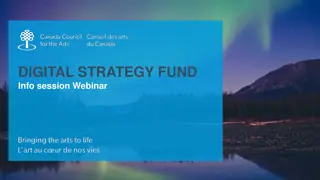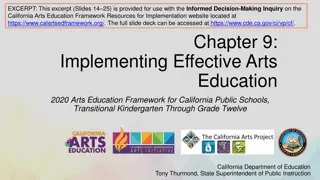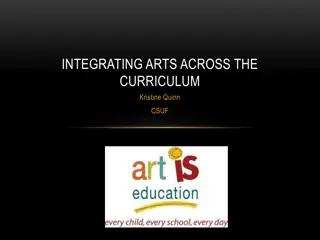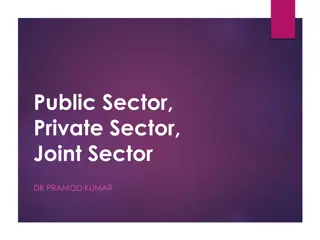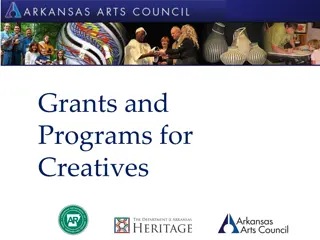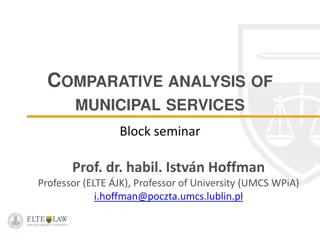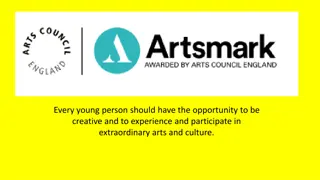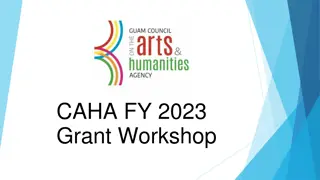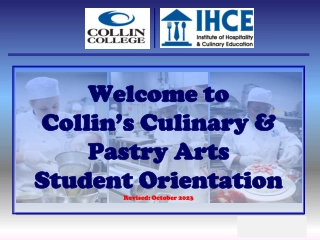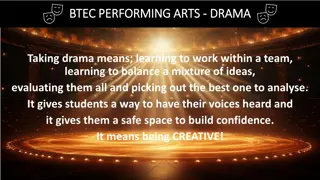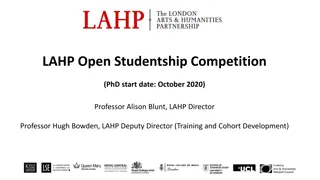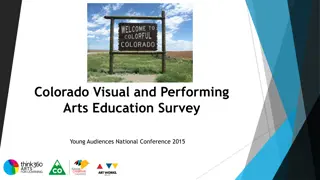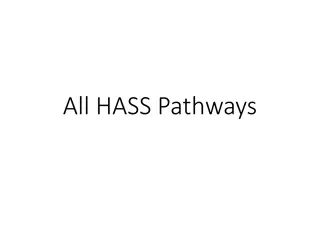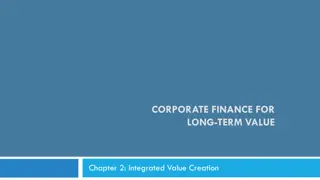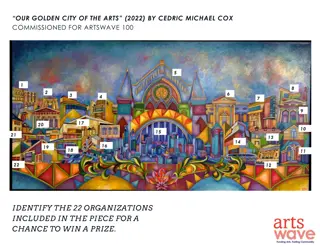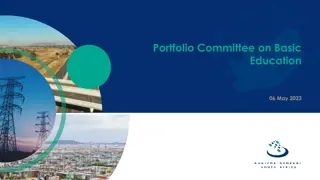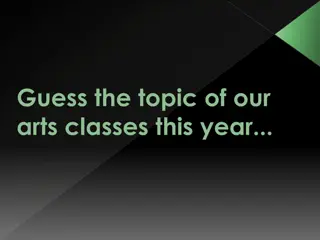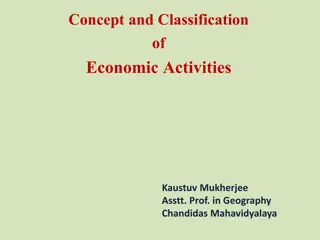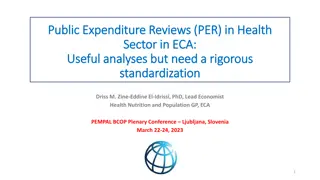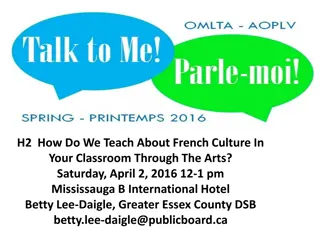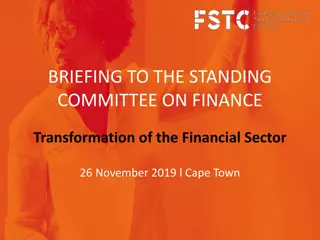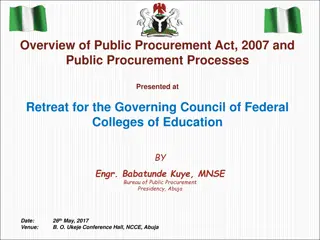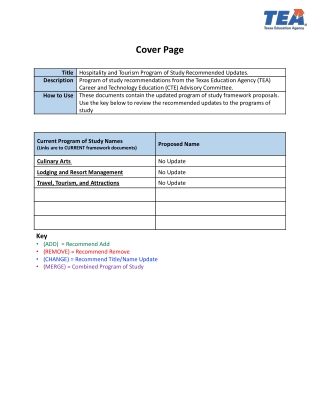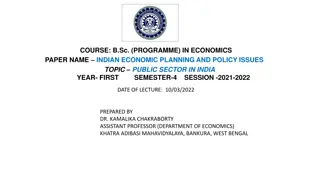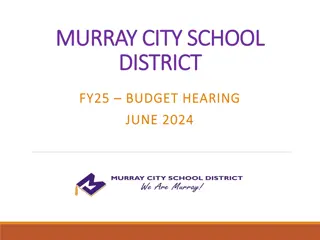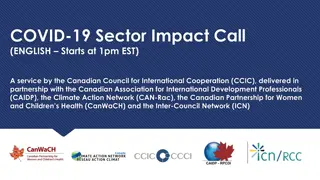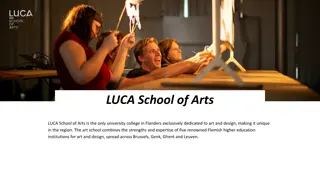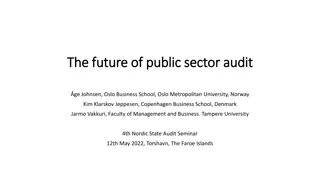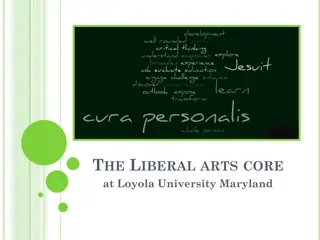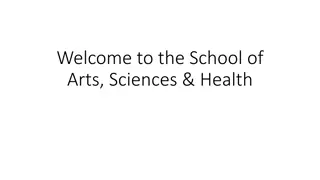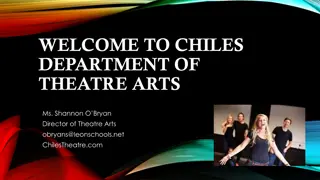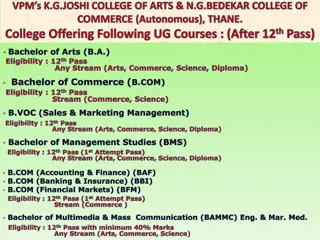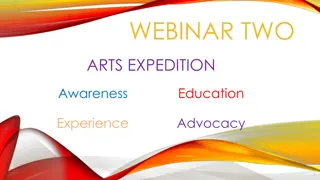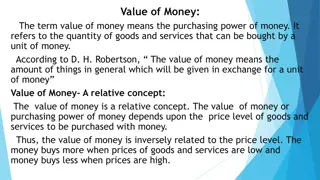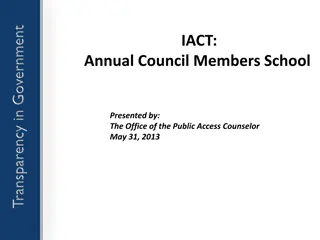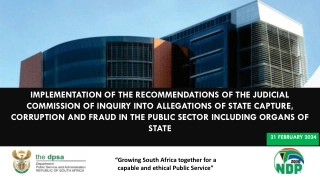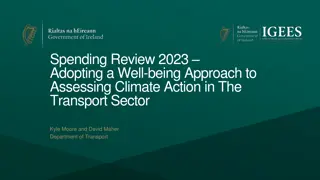Understanding Public Value and Impact in the Arts Sector
Exploring the concept of public value in the arts, this content delves into how arts activities contribute to societal well-being, future generations, and community development. It highlights different types of public value, poses key questions about improving lives, and offers ways to assess the impact of artistic endeavors on individuals and communities.
Download Presentation

Please find below an Image/Link to download the presentation.
The content on the website is provided AS IS for your information and personal use only. It may not be sold, licensed, or shared on other websites without obtaining consent from the author. Download presentation by click this link. If you encounter any issues during the download, it is possible that the publisher has removed the file from their server.
E N D
Presentation Transcript
Demonstrating Your Value and Demonstrating Your Value and Impact In An Evolving World Impact In An Evolving World AUSTRALIA COUNCIL FOR THE ARTS CREATIVE CONNECTIONS WEBINAR SERIES 29 JULY 2020 DR JACKIE BAILEY JACKIE@BYPGROUP.COM 0428 576 372 HTTP://WWW.BYPGROUP.COM
What is public value? What is public value? Future Generations Public value refers to benefits which are (theoretically) equitably accessible to all members of the public, e.g. public parks, clean air, the justice system, national defence, arts and culture. "Nations" Environments Public value also refers to what people value beyond their own or their immediate circle s self-interest. People might have aspirations for future generations; the type of society they want to live in; the planet they care for; the nation they pledge allegiance to. Society Communities Individuals Ancestors
Types of public value Legacy, bequest value Future Generations "Nations" Statecraft, soft power Environments Ecological wellbeing Support for vulnerable groups, social cohesion Society Identity, resilience, belonging Communities Personal development, aesthetic growth, wellbeing Individuals Legacy, contributing to long arc of history Ancestors
Key question: do you make people s lives better?
Ways to think about your impact Ways to think about your impact BYP Group s hearts, minds and bodies model of impact Relational change Welcome and belonging Bridging and bonding Community strength Social capital Cultural change Society Behavioural change Make more positive choices about treatment of selves/others Increased civic, economic and/or creative activity Bodies Skills and knowledge Learn new things Attitudinal change Insights into human potential Change in view of others/self/community Minds The intrinsic experience Emotional response Personal resonance Fun and enjoyment Discomfort and challenge Hearts
How do you know if your activity has made people s lives better? your
Ask: 1. Does my activity have the qualities of arts activities which are known to contribute to social impact? 2. Have the audience members or participants experienced a positive change in their skills and knowledge, emotions, attitudes and behaviours which are known determinants of social impact?
How do you find out if your project How do you find out if your project has made someone s life better? has made someone s life better? Safe / welcoming, adequate level of challenge, creative safety, exposure to difference in a safe space Artistic concept is well-researched, relevant, resonant and robust Regular, active participation tends to be more effective than passive/receptive Experiences leads to emotional response, personal resonance, intellectual stimulation, shared experience, aesthetic growth, productive discomfort Positive artistic climate + Intrinsically rewarding experience This is what we can measure within time and resources. Learning: new skills and knowledge, new economic opportunities Self-efficacy: insight into self, resilience (magnificence), identity, confidence, competence, sense of meaning and purpose Bonding: connection with self, group, Country, culture, land Bridging: connection with others, trust and respect for others, increased understanding and empathy Decolonising: reclaiming identity, history, trauma and stories Healing: strength-based approaches to regain agency, sense of hope and purpose Collective efficacy: community strength Known determinants of individual and community change This causal link is typically beyond our resources, unless we are doing a research project. But some of this has been demonstrated elsewhere and so we can focus on whether we are contributing to the known determinants. Health and mental wellbeing Change in community attitudes Social cohesion Academic engagement and others Social impact
Safe / welcoming, adequate level of challenge, creative safety, exposure to difference in a safe space Artistic concept is well-researched, relevant, resonant and robust Regular, active participation tends to be more effective than passive/receptive Experiences leads to emotional response, personal resonance, intellectual stimulation, shared experience, aesthetic growth, productive discomfort Positive artistic climate + Intrinsically rewarding experience
Learning: new skills and knowledge, new economic opportunities Self-efficacy: insight into self, resilience (magnificence), identity, confidence, competence, sense of meaning and purpose Bonding: connection with self, group, Country, culture, land Bridging: connection with others, trust and respect for others, increased understanding and empathy Decolonising: reclaiming identity, history, trauma and stories Healing: strength-based approaches to regain agency, sense of hope and purpose Collective efficacy: community strength Known determinants of individual and community change
You dont have to re-invent the wheel. You just have to prove that you contribute to the known determinants known determinants of social impact.
THE ARTS EXPERIENCE THE ARTS EXPERIENCE Activity which is linked to positive developmental outcomes comprises a tripartite model of engagement. Behavioural engagement (effort, attendance, persistence) Cognitive engagement (self-regulation, self-efficacy) High quality developmental activity involves all three forms of engagement for example, young people not only attend (behavioural), but also enjoy (emotional) and effectively self- regulate (cognitive) during the activity. Hot cognition is learning that involves personal goals, motivation and emotion cognition steeped in feeling. Arts experiences which combine cognition, emotion and behavioural engagement (motivation and action) can lead to hot cognition. Emotional engagement (interest, enjoyment, valuing) Sources: A. Bohnert, A. Fredricks & E. Randall (2010). Capturing unique dimensions of youth organized activity involvement: Theoretical and methodological considerations. Review of Educational Research 80: 576 610. A. Martin et al, The Role of Arts Participation in Students Academic and Non-Academic Outcomes: A Longitudinal Study of School, Home and Community Factors, Journal of Educational Psychology 2013 105(3): 709-727. J. Catterall, & K. Peppler (2007), Learning in the visual arts and the worldviews of young children , Cambridge Journal of Education 37(4): 543-560.
Early childhood In early childhood, regular music and dance/movement engagement has been proven to have positive social development outcomes for toddlers. BUT the effects cannot always be isolated from the social component AND we need more research into variations between active vs passive participation, and long-term effects and variability of interventions. For example: 6-year old children who took music lessons in voice or keyboard saw little improvement in social skills over a year Children who participated in drama-based education program saw decreases in disruptive behaviour and improvements in self-regulatory behaviours, but no significant changes in pro-social behaviour over the year
School-age children After controlling for prior academic motivation and demographics, high levels of arts engagement amongst school-aged children in school arts-related subjects positively predicts: Adaptive motivation, academic buoyancy, academic intentions School enjoyment, class participation A sense of meaning and purpose, life satisfaction Self-esteem Classroom drama can improve verbal skills Dance can improve visual-spatial skills BUT Arts engagement tends NOT to have a high correlation with improved academic attainment such as formal attainment in standardised tests; arts participation has a positive but low impact on academic learning, and the mechanisms leading to positive impact via the arts are not known Extra-curricular activities can lead to negative behaviours as well, e.g. increased alcohol use with some extra- curricular activities External arts tuition negatively predicts adaptive motivation, academic intentions, school enjoyment, class participation, homework completion, self-esteem, and life satisfaction.
Patients Music listening can have a positive effect on anxiety, stress and pain reduction among patients. Integrating visual arts in hospital design found clinical benefits. Visual arts can help to reduce anxiety and depression amongst cancer patients undergoing chemotherapy. Creative writing on an emotional topic 30- min a day for 4-days led to an improvement in HIV-viral loads immediately and over a 6- month period. Reflective writing can help physicians to develop empathy for patients. BUT Music listening over two months is associated with improvement in focused attention, verbal memory, levels of depression in post-stroke recovery; but hard to know if this is specifically because of the music or just an enjoyable stimulus in general.
Older adults Participatory arts activities (music, singing, dance) are associated with improvements in: Mental health and wellbeing Physical health Engagement with others Attitudes towards ageing among society at large Likelihood of developing dementia later in life is lower for those engaged in leisure activities, with cognitive activities being most important e.g.: reading, board games, playing a musical instrument, dance. Use of fiction helps health care professionals develop empathy and understanding of the lived experiences of people with dementia. Artistic activities can increase tolerance amongst workers, including via collaborative creative workshops with people living with dementia in care homes BUT when it comes to managing dementia, there are mixed results, with some interventions reducing negative behaviours, improving cognition, but many with no improvement. Some staff in the collaborative creative workshops felt threatened by the depth of the experiences, which can lead to discomfort with changing perception of residents less so as patients.
Economic benefits Arts engagement (especially visual arts) amongst children has a strong correlation with later innovation and entrepreneurship. Industries with stronger links to creative industries have stronger innovation performance. Small, local and grassroots community and participatory arts programs have more sustainable positive results for community regeneration. BUT without longitudinal studies, we don t know: if higher levels of innovation are sustained after 6 months The economic wellbeing for residents of increased real estate prices
Wellbeing Cultural participation may improve subjective wellbeing: In one study, cultural access was the second most important determinant of psychological subjective wellbeing after multiple morbidities, ahead of occupation, age, income and education In Scotland there were higher reports of life satisfaction and good health among people with arts/cultural participation There is a correlation between participation in playing music and crafts and subjective wellbeing Community arts activities are associated with healthy living habits and improved understandings of health: Some arts-based health promotion projects get people active who would not typically be interested in typical exercise Arts activities in health promotion has been shown to contribute to healthy eating & mothering, more positive mental health, increased absorption of health information BUT without longitudinal studies, we don t know if healthy habits are sustained. Mental health improvements are difficult to benchmark and measure without control groups.
Social cohesion Participation in the arts may promote prosocial behaviours e.g. volunteering, attending community meetings. Arts participation can raise awareness and change public attitudes e.g. on climate change. For marginalised groups, cultural engagement might be an effective tool for finding voice, identity and recognition. Arts and cultural participation can help healing after traumatic societal events. Reading literary fiction improves Theory of Mind compared to reading nonfiction, pop fiction or nothing at all. Teenagers engaging with literature go through a process of identification and evaluation which helps shape understanding of themselves. Participation in theatre can help develop empathy. BUT: The causal nexus between arts participation and prosocial behaviours is unclear In some instances, listening to music from a particular culture can be divisive and reinforce cultural differences. Culture can also be a negative force in world conflicts.
Participant impact framework How we measure the artistic climate, the intrinsic reward of the arts experience and the contribution of these to the known determinants of social impact
Example of an Arts Project Participant Impact Framework Example of an Arts Project Participant Impact Framework Dimension Experience Collection Method Art is at the heart of Intrinsically rewarding experience Emotional response, Personal resonance, Engagement and concentration, Achievement and challenge, Intellectual stimulation, Aesthetic growth, Bonding, Productive discomfort Self-assessment impact Integrity of process/ Artistic climate for target group Feel culturally and creatively safe, welcomed, treated with respect, validated, acknowledged, equals, adequate support Self-assessment Artistic concept Artistic concept is relevant, resonant, robust Peers/critical reviews What we learn and experience What we think and feel What we do IMPACT EXAMPLES (these are known determinants of social impact ) Skills, Knowledge, Experience Attitudinal Change Behavioural Change Collection Method Self-efficacy / Personal capacity development Increased skills/ knowledge Emotional regulation, emotional buoyancy, future orientation Confidence Self-worth Increased future orientation Belief in own ability to manage Increased sense of choice, own abilities Increased task completion Increase in self-directed activity Observations Self-assessment Self-efficacy / Identity Greater knowledge of possible cultural identities Opportunity to perform and trial identities Increased awareness of identity as fluid Increased sense of own identity Increased pride in own identity Express own identity more readily Increased sense of own voice and identity, which informs decisions Observations Self-assessment Bridging and bonding / Connection Interact with people would not normally interact with; role models for identity and ways to navigate society Increased respect for others Increased belief in others abilities Increased interaction with others Decrease in (micro) aggressive behaviours towards others Observations Self-assessment Collective efficacy / Community strength / Social capital Increased community connections and knowledge of how to access to resources and leverage community strengths Increased positive views of community s strength and own ability to effect change Increased involvement in community- led activity social, civic, economic Increased community-led action Validated instrument questionnaires K N O W L E D G E | E M P O W E R
THE ARTS EXPERIENCE THE ARTS EXPERIENCE Dimension Experience Collection Method Intrinsically rewarding experience Emotional response, Personal resonance, Engagement and concentration, Achievement and challenge, Intellectual stimulation, Aesthetic growth, Bonding, Productive Discomfort Self- assessment Art is at the heart of impact Integrity of process/ Artistic climate for target group Feel culturally and creatively safe, welcomed, treated with respect, validated, acknowledged, equals, adequate support Self- assessment Artistic concept Artistic concept is resonant, relevant, robust Peers/critical reviews, participant views K N O W L E D G E | E M P O W E R
PARTICIPANT IMPACT: PARTICIPANT IMPACT: EFFICACY / PERSONAL CAPACITY- -DEVELOPMENT SELF SELF- -EFFICACY / PERSONAL CAPACITY DEVELOPMENT What we learn and experience What we think and feel What we do IMPACT EXAMPLES Skills, Knowledge, Experience Attitudinal Change Behavioural Change Collection Method Personal capacity development (Resilience, self-efficacy) Increased skills/ knowledge Confidence Increase in self- directed activity Observations Self- assessment Self-worth Emotional buoyancy Increased access to employment/other opportunities Increased future orientation Impulse control Belief in own ability to manage Increased attentional focus Increased sense of K N O W L E D G E | E M P O W E R choice, own abilities
PARTICIPANT IMPACT: PARTICIPANT IMPACT: SELF SELF- -EFFICACY / IDENTITY EFFICACY / IDENTITY What we learn and experience What we think and feel What we do IMPACT EXAMPLES Skills, Knowledge, Experience Attitudinal Change Behavioural Change Collection Method Identity (Self- efficacy) Greater knowledge of possible identities Increased awareness of identity as fluid Express own identity more readily Observations Self- assessment Opportunity to perform and trial identities Increased sense of own identity Increased sense of own voice and identity, which informs decisions Increased pride in own identity Access to role models Increase in positive expressions and behavior towards self and others K N O W L E D G E | E M P O W E R
PARTICIPANT IMPACT: CONNECTION PARTICIPANT IMPACT: CONNECTION (BRIDGING / BONDING) (BRIDGING / BONDING) What we learn and experience What we think and feel What we do IMPACT EXAMPLES Skills, Knowledge, Experience Attitudinal Change Behavioural Change Collection Method Connection (Bridging and bonding) Interact with people would not normally interact with Increased self-respect and respect for others Increase in civic activity Observations Self- assessment Increased belief in own ability to effect change Decrease in anti- social / micro / aggressive behaviours towards others Role models for identity and ways to navigate society Increased insight into other people s abilities Increase in social activity K N O W L E D G E | E M P O W E R
PARTICIPANT IMPACT: PARTICIPANT IMPACT: COLLECTIVE EFFICACY / COMMUNITY STRENGTH COLLECTIVE EFFICACY / COMMUNITY STRENGTH What we learn and experience What we think and feel What we do IMPACT EXAMPLES Skills, Knowledge, Experience Attitudinal Change Behavioural Change Collection Method Community strength (social capital, collective efficacy) Increased community connections and knowledge of how to access to resources and leverage community strengths Increased positive views of community s strength and own ability to effect change Increased involvement in community-led activity social, civic, economic Validated instrument questionnair es Observations Self- assessment Increased community-led action K N O W L E D G E | E M P O W E R
Permission and Ethics Permission and Ethics Risk management Ethical considerations What supports do I need to put in place in case issues arise from questions (e.g. if a question could potentially raise painful memories) Do I have a process in place in case issues arise in answers (e.g. anonymous reporting of intention to self-harm) Parental permission needed for people aged 15 and younger Ethics approval needed for research which goes beyond program evaluation Use findings only for the purposes agreed to by participants Australasian Evaluation Society Guidelines https://www.aes.asn.au/images/stories/files /membership/AES_Guidelines_web_v2.pdf Who has the power? Could I be misusing my power, even unintentionally? Be particularly mindful when working with vulnerable populations e.g. women who have experienced violence, refugees, Indigenous populations with a history of stories being taken from them Consider evaluation co-design, sharing all evaluative outcomes and ownership of stories, and ask about culturally appropriate methods
Ways to talk about your impact Ways to talk about your impact Arts and culture helps me to express and work out: Who I am Who we are Based on John Daley NAVA interview (Grattan Institute) Some useful language Economic participation helping people to be productive members of society Health and wellbeing helping Australians live the healthy lives that they choose Creating jobs jobs for young people Building community resilience trust in institutions, sense of public safety Contributing to the Australian way of life national pride, national identity Providing personal choice giving people options for how they might want to engage with arts and culture, as well as physical activity, mental health services, return-to-work, employment options, small businesses
Useful resources Social Impact Evaluation in the Arts: http://bypgroup.com Existing Frameworks But you don t have to start from scratch! There are some great frameworks out there you could use and adapt (remember though the goals MUST be relevant to your work). Some examples include: Artistic Vibrancy Handbook produced by Australia Council for the Arts Defines 5 dimension of artistic vibrancy that could also be used as an goal framework if outcomes are relevant to your work. Especially useful for reflecting on artistic and instrumental value http://www.australiacouncil.gov.au/strategies-and-frameworks/artistic-vibrancy/ Data collection tools and templates There are also some good resources and templates out to help you collect the data you need. BUT REMEMBER only use tools that will help you collect data that relate directly to your indicators. Outcome reports produced by Arts Queensland to support funded organisations. Includes fact sheets and advice on data collection and some survey templates for different types of activity and participants. http://www.arts.qld.gov.au/funding/outcome_reports.html Capturing the Audience Experience Handbook produced by the New Economics Foundation in and commissioned by the Independent Theatre Council Provides a framework for measuring intrinsic audience impact, survey templates and advice on running a good survey. http://itc-arts- s3.studiocoucou.com/uploads/helpsheet_attachment/file/23/Theatre_handbook.pdf Intrinsic Impact WolfBrown One of the first researchers to try and measure intrinsic impact international consultants WolfBrown provide access to free survey examples via their Intrinsic Impact site. WolfBrown originally worked with the Australia Council on the development of their surveys. http://www.intrinsicimpact.org/resources/free-downloads/ Culture Counts - An online intrinsic measurement platform that captures artist, peer and public feedback on the quality and reach of cultural events. https://culturecounts.cc/
Useful resources Data Comparison When you need to find data or indicators to benchmark against or contextualise your findings these can be helpful ABS Quick stats Great if you need to compare the demographic profile of your participants against the wider population. Searchable by different geographic areas. http://www.abs.gov.au/websitedbs/censushome.nsf/home/quickstats Victorian Audience Atlas produced by Morris Hargreaves McIntyre, commissioned by Creative Victoria Provides a wealth of information about the size and nature of the culture market in Victoria. http://www.health.vic.gov.au/modelling/planning/lga.htm. Arts Nation: an overview of Australian arts produced by the Australia Council Interesting statistics on key aspects of the Australian arts sector including audiences, artists, indigenous arts, international arts and the cultural economy. http://www.australiacouncil.gov.au/research/arts-nation-an-overview-of-australian-arts/ Local Government Area Profiles produced by DHS Way more than you ll ever need, but useful if you want to look at measures of community health and wellbeing. http://www.health.vic.gov.au/modelling/planning/lga.htm.


